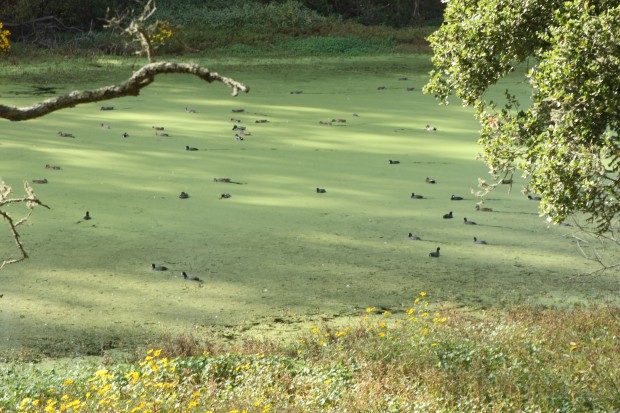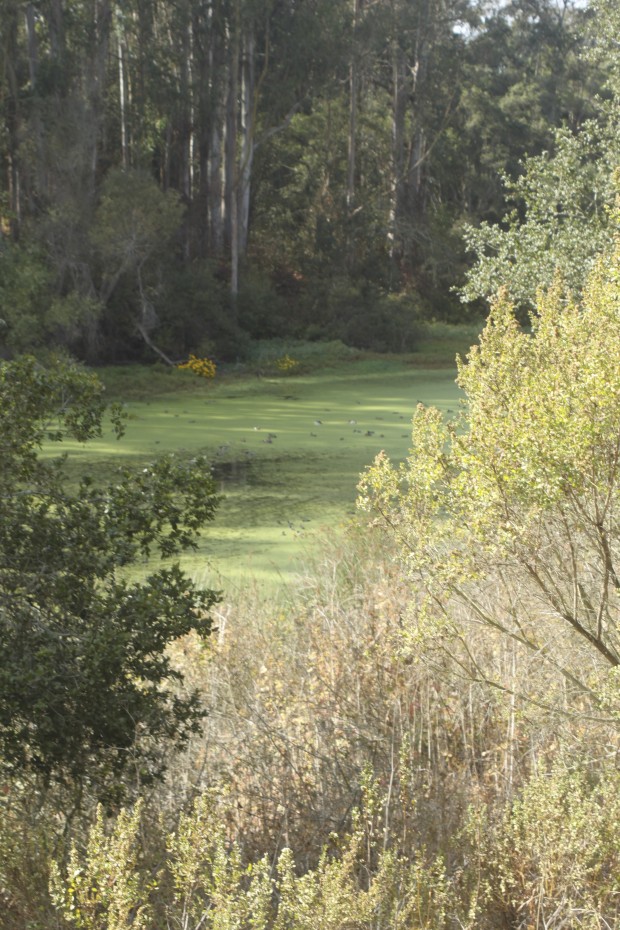A monster lurks in Watsonville, California.
It can poison your dog, give you diarrhea, and cause cancer in sea otters. The mayhem is unintentional – the monster, a microscopic bacterium, is just trying to make a living. But while the microbe thrives in the warm shallow waters of Pinto Lake, they clog the water column with poisonous scum. When they kick into high gear each fall, they create a pollution bonanza that rockets the toxin level to 750 times the allowable limit. The name of the monster is Microcystic aeruginosa, and it’s a species of cyanobacteria – once called blue-green algae.
“They’re a gnarly beast and we’re still trying to figure them out,” said Robert Ketley, the city’s senior utilities engineer. Ketley is a Brit who is invested in saving the lake. It reminds him of a similar lake in South London that kept him out of trouble as a boy.
“This is where people come for their birthday parties, their baptisms,” says Patricia McQuade, a businesswoman who runs the park for the city. “People have brought their kids here for generations.” McQuade formed a community action group called the Friends of Pinto Lake to educate residents about the problem and potential solutions.
Ketley and McQuade are both passionate about saving their lake, but they are up against a formidable foe. In recent years, Microcystis populations have grown, not only in Pinto Lake, but also in the San Francisco Bay Estuary.
“It is the most common toxic cyanobacteria in fresh water and increasing rapidly throughout the world,” says Peggy Lehman, an expert in plankton ecology at the California Department of Water Resources.
Microcystis is so successful in part, because they seem to alter their environment to promote their own growth. Since their cells are buoyant, they sit on the top of the water and soak up the sunshine. They grow so thickly that their blooms prevent sunlight from getting down into the deeper and cooler water below. By keeping the warm water at the top, the cyanobacteria prevent the lake water from mixing, thus preserving their cozy habitat.
Once Microcystis takes root, the normal profile of plankton and algae that populate the lake water completely changes. The plankton that everything eats, such as diatoms, tends to disappear, while unpalatable Microcystis and other potentially toxic cyanobacteria blossom. The organism is so successful at taking in ammonium – a nutrient for growth – that it can outcompete other beneficial organisms and dominate the environment. Additionally, global climate change appears to fuel its spread by creating the warm water habitats that it loves.
Perhaps the strangest thing about these deadly cyanobacteria is that no one knows why they even make toxins. They don’t kill off other competing microorganisms, and since few animals eat them, the toxins aren’t a defense mechanism. Some researchers think that the toxins are a holdover from a previous point in their very long evolutionary history, or that the toxins have something to do with photosynthesis.
“There are over 4,000 or so – or probably 5,000 by now – publications on Microcystis and no one can answer that basic question,” says Lehman.
If Microcystis had any natural enemies, then perhaps an easy remedy could be found. Though their toxins can accumulate in fish tissue and shellfish, there are few species that eat it willingly. Clams even spit it out, says Lehman.
“Because it has this ability to stay down in the bottom mud, it persists over the winter,” says Lehman. “You’re not going to really get rid of it. The question is can you keep it to a level which is not harmful.”
“Not harmful” is perhaps the best goal that Watsonville officials and community groups can hope to attain. Algal blooms have persisted in the lake for decades, but only recently have toxin levels risen to alarming levels.
Preliminary studies of the lake and its watershed have identified the main problem: excess nutrients from fertilizer runoff, leaking septic systems and the lake’s own sediments are fueling the cyanobacterial blooms. Though a county park surrounds the north side of the lake, houses line the west side, and the remaining lakefront property is farmland.
Stopping the blooms will require coordinated action on the part of scientists, conservation groups, community members, and farmers. Not only must the city remove the existing nutrients – mainly the element phosphorus – but they must prevent any additional nutrients from entering from loose soil, poor farming practices and leaking septic tanks.
The most popular treatment for phosphorus is the addition of large quantities of a mineral called alum to the lake. Alum binds to the phosphorous and sticks to the bacterial cells so that they clump up and settle at the bottom. It also helps seal off the phosphorous-laced sediments. Alum treatments are generally safe, but engineers must monitor water quality so that pH changes do not kill off fish and smaller animals.
Researchers and officials are also considering floating mats of vegetation that would draw the phosphorus into the plants. They are working with local farmers to reduce runoff, and planting cover crops in the watershed to stop erosion. Additionally, the city is looking into putting in sewer lines to the houses that line the lake.
One of the stranger remediation strategies is a program that Ketley developed, called “Carpageddon.” Watsonville will pay fisherman to catch the invasive carp that inhabit the lake. Since the fish are bottom feeders, they stir up the sediment and release more phosphorous into the water.
Despite the challenges, Pinto Lake and its surrounding watershed are small enough that the residents have a good chance of controlling the phosphorous. Residents are optimistic that community involvement and targeted water treatments will tame the cyanobacterial monster in the Lake.
“It’s not going to be very hard to rally every single person in Watsonville,” says McQuade. “Every single person in Watsonville has been to this lake sometime and all I have to do is get to all of them.”

